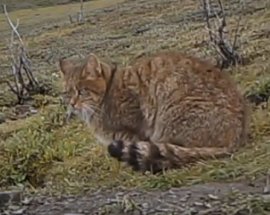Chinese mountain cat (Felis silvestris bieti)

One of the rarest and most elusive types of wild cat lives high on the Tibetan plateau. In fact until recently most of what was known about these cats came from a few animals in Chinese zoos and skins tucked away in museums. So it was known that the Chinese mountain cat is a stocky wild cat, slightly larger than domestic cats. The cat's fur is light-brown with a whiter underbelly. The adult cats have no distinct markings with the exception of the tails which have dark bands at the end of the tail and a dark tip.
Recently automatic cameras have been able to capture these shy nocturnal creatures in digital images so we now have some idea how these cats live in their natural environment.
Yet many questions have remained unanswered. What is the taxonomy of those cats? Is the Chinese mountain cat a true species or a subspecies of wildcat (Felis silvestris)? Did these cats contribute to cat domestication in East Asia? (It has been suggested that there has been some degree of interbreeding between Chinese mountain cats and domestic cats. Do Chinese domestic cats share genes with the mountain cat?)
We know that most domestic cats (Felis catus or Felis silvestris catus) originate from the African wildcat (F.s. lybica) in the Near East. Ancient DNA analysis of cat remains in archaeological sites confirmed that African wild cats were the ancestors of the domestic cats now found in every part of the world. Yet no-one had studied Chinese domestic cats to see if Chinese mountain cats are part of their genetic makeup.
A new study published in Science Advances (June 2021) has now answered some of those questions and put the Chinese mountain cat on the taxonomy map. The study was carried out in the Laboratory of Genomic Diversity at Peking University in Beijing and was supported by an international team including lead genetic researchers at Nova Southeastern University, USA and in Malaysia.
Genetic samples of cats across China were analysed, including those from domestic cats, Asiatic wild cats and Chinese mountain cats. (The Asiatic wildcat F. s. ornata has a distinct spotted coat pattern which differentiates them from other usually striped wild cat lineages. Asiatic wild cats can be found from the eastern Caspian Sea north to Kazakhstan to western India, western China, and southern Mongolia.)
Using 270 individual samples, the researchers were able to show that the Chinese mountain cat is a unique subspecies - Felis silvestris bieti - of the widespread wildcat species Felis silvestris. It appears that Felis silvestris bieti is found only in China, making itself at home in the alpine climate of the Tibetan plateau.
Furthermore, He Yu (the leading author of this study) and his colleagues found that the genetic makeup of Chinese domestic cats shows a lineage originating from the African wildcat (F.s. lybica). This has ruled out the intriguing hypothesis that Chinese mountain cats once interbred with domestic cats to make Chinese domestic cats a special breed of their own.
To study the common ancestry of both F.s. bieti and F.s. ornata, He Yu and his colleagues used the molecular clock hypothesis. The molecular clock hypothesis states that DNA and protein sequences evolve at a rate that is relatively constant over time and among different organisms. A direct consequence of this constancy is that the genetic difference between any two species is proportional to the time since these species last shared a common ancestor. Therefore, if the molecular clock hypothesis holds true, this hypothesis serves as a useful method for estimating evolutionary timescales.
Applying the molecular clock hypothesis to the Chinese wild cat, the researchers estimated the date of evolutionary split between F. s. bieti and F.s. ornata at around 1.5 million years ago. On the other hand, when compared to the Chinese Mountain Catís closest relative in the Felis species, the black footed cat (Felis nigripes), both species showed the split at around 3 million years ago. So F.s bieti and F.s. ornata are more closely related, which supports the classification of F.s. ornata and F.s. bieti as a subspecies of Felis silvestris.
"This study will help conservation scientists to identify threats and decide the best ways to conserve this special cat in its native range," said Stephen J. O'Brien, Ph.D., a geneticist and research scientist at NSU's Halmos College of Arts and Sciences and a co-author of this study.
Journal Reference:
He Yu, Yue-Ting Xing, Hao Meng, Bing He, Wen-Jing Li, Xin-Zhang Qi, Jian-You Zhao, Yan Zhuang, Xiao Xu, Nobuyuki Yamaguchi, Carlos A. Driscoll, Stephen J. O'Brien, Shu-Jin Luo. Genomic evidence for the Chinese mountain cat as a wildcat conspecific (Felis silvestris bieti) and its introgression to domestic cats. Science Advances, (2021) vol 7(26). https://advances.sciencemag.org/content/7/26/eabg0221

